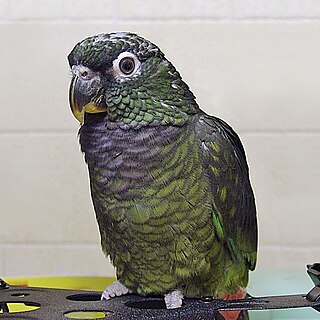
The Andean goose is a species of waterfowl in tribe Tadornini of subfamily Anserinae. It is found in Argentina, Bolivia, Chile, and Peru.

The green-cheeked parakeet, also sometimes known as the green-cheeked conure in aviculture, is a species of bird in subfamily Arinae of the family Psittacidae, the African and New World parrots. It is found in Argentina, Bolivia, Brazil, and Paraguay.

The cliff parakeet is a Near Threatened species of bird in subfamily Arinae of the family Psittacidae, the African and New World parrots. It is endemic to Bolivia.

The white-eyed parakeet, known in aviculture as white-eyed conure, is a species of bird in the subfamily Arinae of the family Psittacidae, the African and New World parrots. It is found in every mainland South American country except Chile and also on Trinidad.

The blue-cheeked amazon, also known as blue-cheeked parrot or Dufresne's amazon, is a Near Threatened species of bird in subfamily Arinae of the family Psittacidae, the African and New World parrots. It is found in Brazil, the Guianas, and Venezuela.

The needle-billed hermit is a species of hummingbird in the family Trochilidae. It is found in Bolivia, Brazil, and Peru.

The semicollared puffbird is a species of near-passerine bird in the family Bucconidae, the puffbirds, nunlets, and nunbirds. It is one of seven species of the genus Malacoptila. It is found in Bolivia, Brazil, and Peru.

The spot-winged falconet is a species of bird of prey in subfamily Falconinae of family Falconidae, the falcons and caracaras. It is found in Argentina, Bolivia, Paraguay, and possibly Uruguay.

The Andean gull is a species in subfamily Larinae of the family Laridae, the gulls, terns, and skimmers. It is found in Argentina, Bolivia, Chile, Colombia, Ecuador, and Peru.

The cobalt-winged parakeet is a species of bird in subfamily Arinae of the family Psittacidae, the African and New World parrots. It is found in Bolivia, Brazil, Colombia, Ecuador, Guyana, Peru, and Venezuela.

The tui parakeet is a species of bird in subfamily Arinae of the family Psittacidae, the African and New World parrots. It is found in Bolivia, Brazil, Colombia, Peru, and possibly Ecuador.

The rusty-faced parrot is a Near Threatened species of bird in subfamily Arinae of the family Psittacidae, the African and New World parrots. It is found in Colombia and Venezuela and possibly Ecuador.

The scaly-headed parrot is a species of bird in subfamily Arinae of the family Psittacidae, the African and New World parrots. It is also called scaly-headed pionus, Maximilian pionus, Maximilian parrot, Maximilian's pionus, or Maximilian's parrot. It is found in Brazil, Bolivia, Argentina, and Paraguay.

The blaze-winged parakeet, known as the blaze-winged conure in aviculture, is a species of bird in subfamily Arinae of the family Psittacidae, the African and New World parrots. It is found in Brazil, Bolivia, Paraguay, and possibly Argentina.

The Andean potoo is a species of bird in the family Nyctibiidae. It is found in Bolivia, Colombia, Ecuador, Peru, and Venezuela.

The pallid dove is a species of bird in the family Columbidae. It is found in Colombia, Ecuador, and Peru.

The ocellated piculet is a species of bird in subfamily Picumninae of the woodpecker family Picidae. It is found in Bolivia and Peru and possibly Argentina.

The fine-barred piculet is a species of bird in subfamily Picumninae of the woodpecker family Picidae. It is found in Brazil and Peru.
The Sinú parakeet is a bird in subfamily Arinae of the family Psittacidae, the African and New World parrots. BirdLife International's Handbook of the Birds of the World recognizes it as a full species. The International Ornithological Committee (IOC), the South American Classification Committee of the American Ornithological Society, and the Clements taxonomy treat it as a subspecies of the painted parakeet.

The Tatama tapaculo is a species of bird in the family Rhinocryptidae. It is endemic to western Colombia.






















